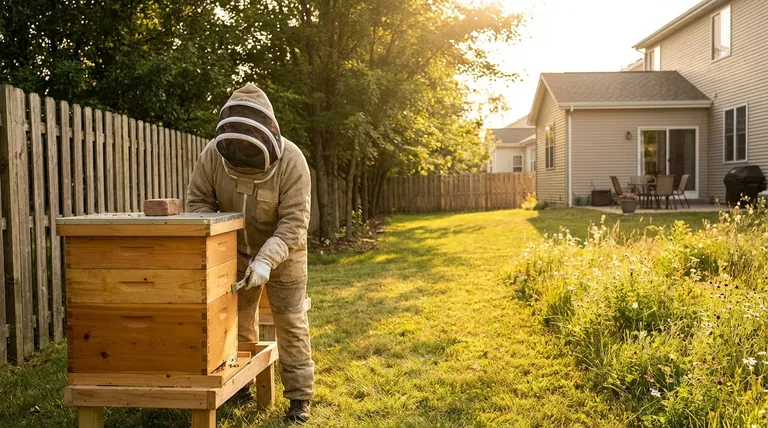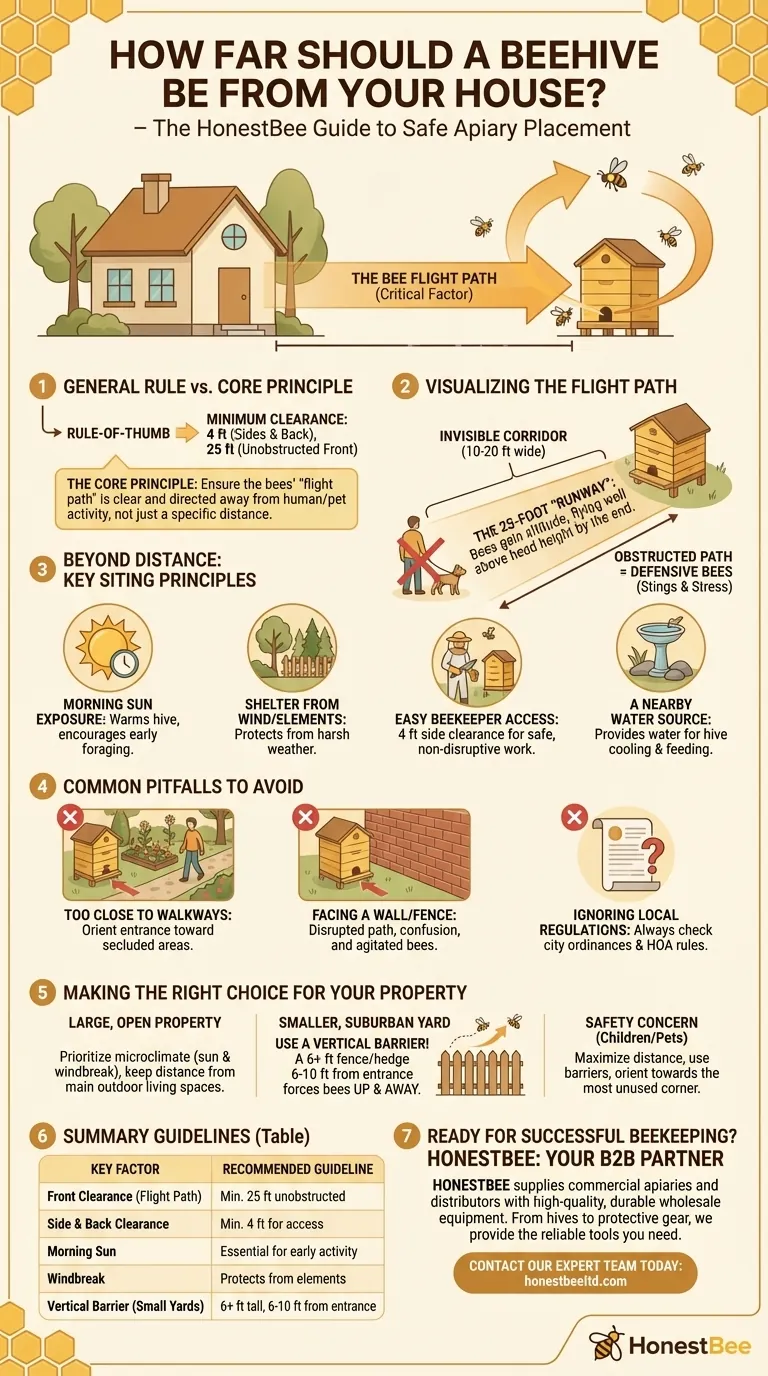As a general rule, a beehive should have a minimum of 4 feet of clearance on its sides and back, with at least 25 feet of unobstructed space directly in front of the entrance. However, these numbers are merely a starting point. The ideal placement is less about a single measurement and more about understanding and respecting the bees' daily routine.
The core principle is not about a specific distance from your house, but about ensuring the bees' "flight path"—the direct line out of the hive entrance—is clear and directed away from areas of human and pet activity.

The Critical Factor: The Bee Flight Path
To safely situate a hive, you must first understand how bees operate. They are creatures of habit and efficiency, and their path to and from the hive is their superhighway.
What is a flight path?
The flight path is the invisible corridor, typically 10-20 feet wide, that bees use when exiting and entering the hive. Foragers will emerge and fly in a straight line, gaining altitude as they go.
Why clearance is essential
If this path is obstructed by a person, a pet, or frequent movement, the bees can become defensive. They interpret blockages as a threat to the colony, which can lead to unnecessary stings and stressed bees.
The 25-foot "runway"
The 25-foot minimum clearance is a guideline to ensure bees have enough space to gain altitude. By the end of this "runway," they are typically flying well above head height, minimizing any interaction with people on the ground.
Beyond Distance: Key Siting Principles
Successful hive placement balances the needs of the bees with the needs of the beekeeper and their neighbors. Several factors are just as important as the flight path.
Morning Sun Exposure
Place your hive where it will receive direct sunlight early in the morning. This warms the hive and encourages the bees to get out and start foraging earlier in the day, leading to a more productive colony.
Shelter from Wind and Elements
A natural windbreak, like a line of trees or a solid fence behind the hive, can protect it from harsh winter winds and driving rain. This helps the bees maintain a stable internal temperature without expending excess energy.
Easy Beekeeper Access
The 4-foot clearance on the sides and back is for you. You need a safe, clear area to work the hive from the side or behind, which is less disruptive to the bees than standing in their flight path.
A Nearby Water Source
Bees need water to cool the hive and feed their young. Providing a dedicated water source with landing spots (like a birdbath with rocks in it) will keep them from seeking water from your neighbor's pool or your pet's water bowl.
Common Pitfalls to Avoid
Many placement mistakes stem from focusing only on distance while ignoring the context of the surrounding environment.
Placing Hives Too Close to Walkways
A hive can be 50 feet from your door, but if its entrance faces a frequently used garden path, you will have problems. Always orient the hive entrance toward a secluded, low-traffic area of your property.
Facing the Entrance Towards a Wall
Never face a hive entrance directly toward a nearby house or solid fence (less than 10-15 feet away). The bees' flight path will be disrupted, causing confusion, traffic jams at the entrance, and agitated bees.
Forgetting Vertical Barriers
For smaller yards, a vertical barrier is your most powerful tool. A solid fence, hedge, or screen that is at least 6 feet tall and placed about 6-10 feet in front of the hive entrance forces the bees to fly up and over it immediately. This effectively lifts their flight path above any nearby human activity, drastically reducing the required horizontal clearance.
Ignoring Local Regulations
Before you place your hive, always check your local city ordinances and any Homeowners' Association (HOA) rules. Some municipalities have specific setback requirements for beehives.
Making the Right Choice for Your Property
Your ideal hive location will depend entirely on your specific landscape and goals.
- If you have a large, open property: Prioritize an ideal microclimate with morning sun and a windbreak, keeping the hive a comfortable distance from your main patio or outdoor living spaces.
- If you have a smaller, suburban yard: Use a tall fence or dense hedge as a vertical barrier to direct the bee flight path up and away, allowing for safe placement in a more compact space.
- If your primary concern is safety for children or pets: Maximize distance, use physical barriers, and orient the hive entrance toward the most unused corner of your property, such as a back fence or wild area.
Thoughtful placement is the foundation of a safe and successful beekeeping experience for both you and your bees.
Summary Table:
| Key Placement Factor | Recommended Guideline |
|---|---|
| Front Clearance (Flight Path) | Minimum 25 feet of unobstructed space |
| Side & Back Clearance | Minimum 4 feet for beekeeper access |
| Morning Sun Exposure | Essential for early foraging activity |
| Windbreak | Protects hive from harsh elements |
| Vertical Barrier (for small yards) | A 6+ ft fence/screen 6-10 ft from the entrance |
Ready to start your beekeeping journey with the right equipment?
As HONESTBEE, we supply commercial apiaries and beekeeping equipment distributors with high-quality, durable supplies through our wholesale-focused operations. From hives and protective gear to essential tools, we provide the reliable equipment you need for successful hive management and placement.
Contact our expert team today to discuss your wholesale needs and ensure your apiary is built on a foundation of quality and safety.
Visual Guide

Related Products
- HONESTBEE Advanced Ergonomic Stainless Steel Hive Tool for Beekeeping
- HONESTBEE Professional Long Handled Hive Tool with Precision Cutting Blade
- Long Langstroth Style Horizontal Top Bar Hive for Wholesale
- Professional Dual-End Stainless Steel Hive Tool for Beekeeping
- Langstroth Bee Hives Bee Keeping Box for Beginners Beekeeping
People Also Ask
- What are the basic tools for beekeeping? Essential Starter Kit for Safe & Successful Hive Management
- What are some common uses of a hive tool? Essential Multi-Purpose Tool for Every Beekeeper
- What is a hive tool and what are its uses? Master Your Hive Inspections with the Essential Beekeeper's Tool
- Why do hive tools have a hole? Unlock the Secret to Efficient Beekeeping
- How should beekeepers handle bees when using a hive tool? Master Calm, Deliberate Techniques



















